Choosing a tabletop hydraulic press
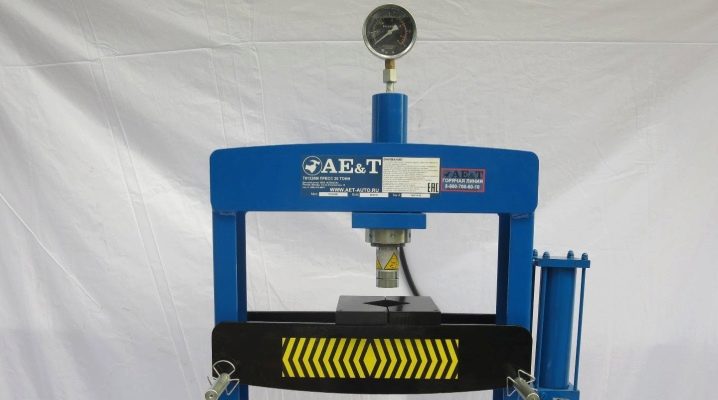
The benchtop hydraulic press is suitable in cases where the applied pressure requires close visual inspection by the operator of this unit. Most modern models released in the 2010s have a CNC program unit, where the force applied to the workpieces is controlled without human intervention.


Features and purpose
The press itself is designed to apply a force of more than 100 kg to each work piece. The entire weight falls mainly on the surface of the squeezed part, element, component. A hydraulic press, in contrast to a mechanical one, is based on the transfer of pressure from the side of the liquid, which under normal conditions is very difficult to compress, or rather, almost impossible. Whether the press contains oil or water, its properties, characterized by high efficiency reaching more than 90%, are practically the same. However, so that the steel cylinders, in which the pistons move, do not oxidize, oil is used - transmission, brake, industrial. In some cases, brake fluid can be used in a hydraulic press, and for long-term preservation of the greatest possible efficiency, the inner walls of the vessels are regularly cleaned of metal, polymer and oil deposits. Theoretically, instead of engine oil, it is possible to fill in a hydraulic press and working off - its properties will not change.


The tabletop hydraulic press allows the worker to be free from the need to bend down frequently at work. A craftsman can spend half a day or more on his feet, feeding and removing parts during the processing. The simplest medium-sized desktop L-shaped press is made on the basis of a jack. It resembles an enlarged 20 times a screw clamp. The same press is put on the floor - there is no fundamental difference here. The hydraulic press is equipped with a discharge valve and a shut-off valve to prevent oil spilling out when a noticeable force is applied to the pistons. An equally important mechanism is the pump itself, which, using a lever, supplies the required amount of oil into the working vessels, in which pressure is created, pressing the piston together with the rod towards the gearbox, which transfers the force to the movable (squeezing) platform.


An important element that distinguishes a bench press from a floor press is this lever with an oil supply mechanism.
The stem of the bench press can be positioned horizontally or vertically. This makes it possible to process hard-to-reach places of pressed workpieces. To create more squeezing force, the worker will use another version of the press, where a foot pedal can be used instead of a hand lever: it is more convenient to press with the whole weight than using solely the muscle strength of the arms. Mechanized presses to pump oil into cylinders use a compressor that creates a pressure of tens of atmospheres.
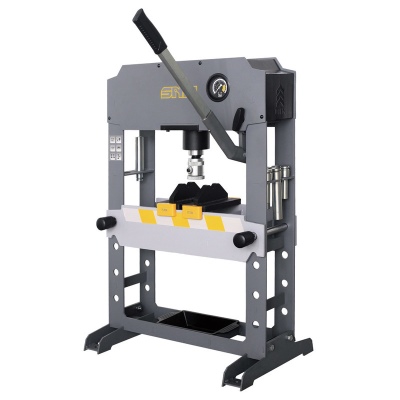
For the rest, desktop presses are not much different from floor presses and are considered according to the same criteria: direction of the rod, tonnage of the developed compressive force, dimensions, occupied area and more.

Popular models
AE&T T-61210 Chinese Press designed for a maximum compression of 10 tons. Compact, lightweight, used in small service stations and in mini-production that does not use engines.
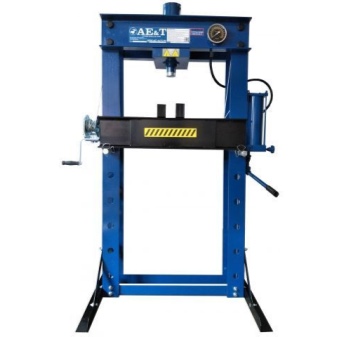

Nordberg N3610 - another model from China, competing with the previous version. Designed for the same pressure. Differs in a slightly higher cost.The stroke is 18 cm compared to 135 mm for the previous one, weight is 51 (versus 50) kg.

KSC-15 from Nordberg designed for 12 tons of effort. Suitable for masters taking to the next level. Its other parameters do not differ significantly from the previous options.

Gigant GHP-10 designed for 10 tons. Ergonomic - it is easier to operate the mechanism, pumping the cylinders with working fluid. Suitable as one of the basic tools in automotive workshops, small production. Superseded the Inforce 05-14-01 model. The stem moves 17 cm. The pump is supplied as a set. It features a reinforced frame and is designed for many years of use.

Selection Tips
Decide what kind of press you need for the pressure applied. For example, pressing briquetted plastic waste does not require more than 4-10 tons of effort: polymers are quite malleable to bend and crumple. Such devices are suitable for people who are heated by sawn timber residues and plastic waste. But for stamping non-ferrous metal and steel, it is advisable to take a 20- or 30-ton press, respectively.

The table press is a device with limited mobility. It does not belong to the lightweight class, and although it is often used as a device carried by a car, its use is mainly limited on a workbench that can withstand a weight of the order of hundreds of kilograms. It can also be used as an outdoor one, however, the workers working on it must have keen eyesight so as not to lean closer, since it is inconvenient to work in a bent position. For frequent work outside the workshop, use homemade presses made from a jack, or move it with a workbench, for example, under a canopy in the yard. The 50 kg weight cannot be moved alone - this work is done with several helpers.
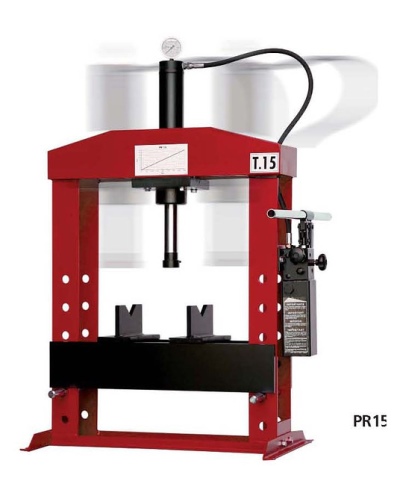
Do not use presses for light work, for example, made of aluminum. Despite their approximately three times less weight, they are not designed for processing hard materials - aluminum is easily damaged. Do not try to process metal and hardwood parts, some types of composite materials with such presses.
Features of operation
Before starting work, check the oil level in the cylinder. Make sure that the workpiece to be processed is securely fixed on the object platform (stationary "half" of the press unit, as a rule, rigidly connected to the frame).

Air bubbles entering the space will immediately lead to ineffectiveness of the "handbrake", which creates working pressure. Gas, unlike liquid, is compressed so that its volume decreases up to tens of times. To develop the necessary effort, you will have to work longer, or the appearance of serious errors in work is possible: "under-stamped" parts made of non-ferrous metal are a natural phenomenon.
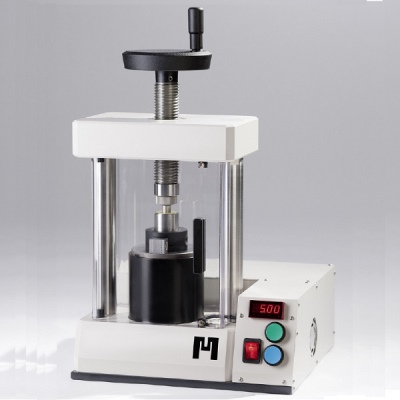
In addition to the oil level, the condition of the seals in the cylinders is checked.
If they are cracked, tears appear, then oil will leak through them. The press will not develop the required pressure, while losing a significant amount of liquid from the cylindrical vessels.














The comment was sent successfully.